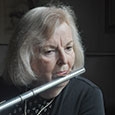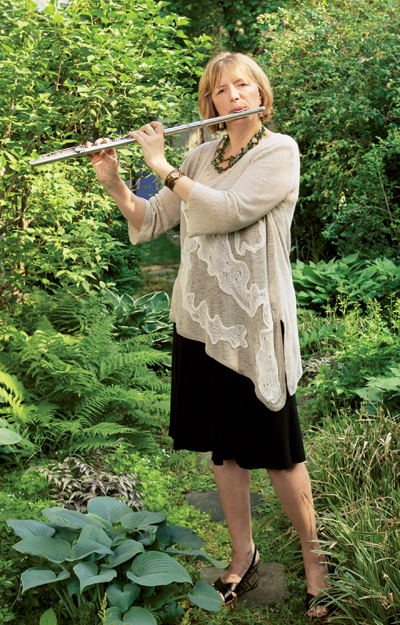 Flutist Linda Toote surprised the flute world when she resigned her principal flute position in the Milwaukee Symphony to move to Boston a few years ago. Her husband had just won a position as oboist with the Boston Symphony Orchestra. When the two musicians married, they agreed that whoever won the best job, the other would follow. Toote gave up the guarantees of a symphony position for unknowns of life of as a free-lancer.
Flutist Linda Toote surprised the flute world when she resigned her principal flute position in the Milwaukee Symphony to move to Boston a few years ago. Her husband had just won a position as oboist with the Boston Symphony Orchestra. When the two musicians married, they agreed that whoever won the best job, the other would follow. Toote gave up the guarantees of a symphony position for unknowns of life of as a free-lancer.
After earning a Bachelor of Music degree from the Mannes College of Music in New York where she studied with John Wion, Toote went to Yale University to work with Tom Nyfenger for her Master’s degree. While there, she won her first full-time orchestral position as assistant principal/2nd flute in the Orquesta Sinfonica del Estado de Mexico. She debated on whether to take the position or finish her degree, but Nyfenger advised, “You’re in school to get a job, and the job came first. Go.” After performing in Mexico, she held a succession of orchestral positions including 2nd flute in the Florida Symphony (Orlando) for two years, principal flute in the Florida Orchestra (Tampa) for four years, assistant principal in the Atlanta Symphony for three years, and finally principal flute in Milwaukee for five years.
Once in Boston, she had no idea what she might do. “As it turned out, I ended up substituting practically full-time with the Boston Symphony for these past 15 years on both piccolo and second flute. In addition, I also held principal flute positions with the Lake George and Santa Fe Opera companies. I now serve as principal flute of the Boston Lyric Opera Company and play piccolo in the Boston Pops Esplanade Orchestra. I am also the full-time flute professor at Boston University, on the faculty at Boston Conservatory, and Director of the Flute Workshop at the Boston University Tanglewood Institute.”
How do you find balance in your life since both you and your husband are professional musicians?
I’m still trying to find it, but according to my closest friends, I’m not really close. My husband has a more or less reliable schedule, but is out three or four nights a week. I am busy at the Opera, Boston University and Boston Conservatory, and sometimes the Boston Symphony or Pops as well. As a free-lancer my schedule is completely irregular. Luckily my children (twins) are now 14 and can be home alone for at least a few hours at a time. My kids also have peripatetic schedules. They are also musicians (violin and cello) and are active in all of their school theater productions. Some days we are going in four different directions at once.
In addition to the giant calendar on the refrigerator, we now employ all the fancy calendars on the computer to help us. Inevitably we get things wrong from time to time. In general, in a free-lancer’s life, I don’t find that there is regularity which allows me to plan ahead. It’s feast or famine. Sometimes several important events crop up at once and then conversely, it can be very quiet for a while. The quiet times are nice for catching up, finding the bottom of the desk, getting to spend quality time playing long tones, and devoting more time to activities at home.
Did you always want to be a flutist?
When I was in the 3rd grade, the classroom music teacher, a Joni Mitchell type who visited once a week with her guitar, told my mother, “Get this girl an instrument,” so evidently my interest was unambiguous. The best my Mom could do at the time was to sign me up playing fife in a Fife and Drum Corps which met once a week and cost $1. It was a few more years down the road before an instrument came my way. A second cousin, who had just graduated from high school, no longer wanted her flute. She asked if we would be interested, and we gladly accepted her offer. I was fatally bitten by the bug in a pivotal moment in 8th grade during the Borodin Polovetsian Dances. From that time on, even though I had no idea what it meant to be a professional musician or what the lifestyle would be like, I just knew that this was what I wanted to do around the clock.
Who were your early influences?
I cannot express just how much I owe to my first instrumental teacher, Robert Filangeri, who taught my beginning flute lessons. He was a clarinet and saxophone major during his college years and was now the band and wind ensemble director at my junior high school. He took me under his wing in every conceivable way. To say that he gave generously of his time would be a ridiculous understatement. He nurtured, guided, and inspired me, shopped for instruments with me, and got me started in a professional concert band on Long Island that was made up of music teachers. Then of course, once I got to college I have John Wion to thank for continuing in that role.
Where would we be without these kinds of mentors? This is a beautiful almost anachronistic tradition in our industry. I try to do the same for my up and coming students. They look to us for so much more than advice on what fingering to use in a difficult passage.
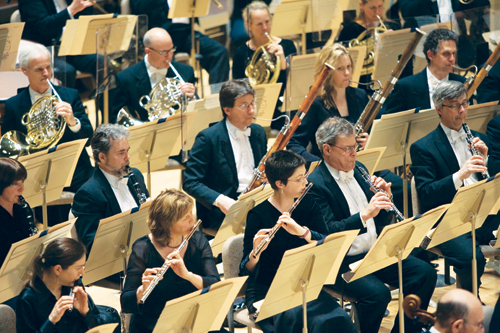
What is the most difficult position to play – principal flute, second, or piccolo?
This is a wonderful question and one about which young flutists should give serious thought. Anything done as well as you can is a challenge. If it’s easy, you’re not trying hard enough. Each position has its own set of skills specific to the position. When you sit in the principal chair, in addition to having your act together as a flutist, you must be able to command attention when the music demands it and offer a musical opinion that is communicated through phrasing, choice of colors, dynamics, pacing, and articulation. You learn to adapt to the role as one of the four wind principals (flute, oboe, clarinet and bassoon) and always do your part to knit the wind section together.
As a second flutist, the skill set is in some ways quite different. You must possess the willingness to subordinate your own musical agenda to second place, taking subtle cues from the principal. The second flutist strives to respond to the style tendencies of that player, anticipating what they might do. A good second flutist will never over power the dynamic level set by the principal player, will not employ rogue vibrato when the principal does not, would never shape the phrase or articulate to their own liking, or hang over the ends of notes. This is just scratching the surface of a long list of invisible skills.
An expert second flutist understands how to place notes in a chord vertically, tuning often with the second clarinet, oboe, bassoon or horn. Gertrude Stein might think, ‘A rose is a rose, is a rose,’ but an A is not always an A. An A 440 is not always 440 Hz. It might be if you are the root of the chord, but it will change if you are the 3rd, 5th or 7th. Successful second flutists know the harmony, their place in it, and how to tune chords. It is often said that when a second player is doing his job, he should not be noticed unless his musical line is prominent.
No matter what position you play, it is important to be aware of the decorum required as a good colleague. If a colleague has a big solo coming up, then sit still and do not fidget. This is not the time to clean out the flute, cigarette paper pads, adjust the music stand, etc. As a second flutist, do you sit relatively still when others play, or do you stir the soup, or make windmills out of your arms? Count the bars rest (or even better, know the music intimately, with cues written in the part) so that if a section mate is lost, you can assist. What if a gust of wind were to blow closed the music of the principal’s or piccolo’s music? Second flute to the rescue! I have played many a concert on all sides of the equation, and I gladly perform this service or am happy to be saved from an embarrassing mistake myself. These skills are a feather in your cap, and make you a valued and trusted colleague. They may also lead to being hired a second time.
Piccolo, is it the demon, diva or the delinquent of the orchestra? Well, it can be all three of course. A good piccolo player is a considerate colleague who does not sit on stage in close proximity to others warming-up on fiendishly difficult and high passages, thereby deafening all around them. This wins many friends right off the bat. A few words of warning every now and then to the second violins about a fortissimo high B at letter R in the score, will keep people speaking to you at the break. You may even want to keep a stash of ear plugs to pass out if Shostakovich Symphony No. 11 is on the docket. Remember ear plugs can be bought in bulk.
A critical skill for this most twitchy of instruments is an impeccable sense of pitch because obviously the piccolo cannot hide. Every note is heard. Piccoloists are also somewhat at the mercy of the potential inconsistencies of the rest of the wind section. Just as being at the top of a ladder in a hurricane is a less desirable position than being on the ground, piccolo players are subject to sounding out of tune even if they are right where they think a note should be placed or in sync with a hypothetical tuner. The sense of pitch should be so good, that you are able to flex it if necessary. If piccolo players have exquisite control of all extremes of register and dynamics, it sets them apart from the crowd. Someone once said that playing the piccolo is like hours of boredom punctuated by moments of sheer terror. Beethoven 9, Tchaikovsky 4, and Brahms 4 are the first three excerpts that come to mind. Piccoloists sit for a good long time, often long enough to get nerves worked up, a cold instrument, dry lips, you name it, and then they take a running leap onto the musical tightrope. It is not a bad idea to quietly double along a bit at a lower octave with the flutes somewhere earlier in the piece, like joggers who keep running in place when they come to a stop light. Another helpful bit of practice advice for the piccolo might be to record whatever treacherous excerpt you are practicing on the flute, the instrument on which you might consider yourself more accomplished. Check for perfect intonation. Then play the piccolo part along with your prerecorded stable lower octave.
Boston has a fabulous tradition of this kind of section playing, promoted by one of my colleagues and predecessors, Fenwick Smith. He understood and embraced the concept of the wind choir and set a standard for those who play in the flute section.
I enjoy playing all positions, and when performed well, all positions are rife with challenge and reward. After spending most of my career in principal positions, it has been energizing to get my feet wet, learning to sit in the other chairs.
Had you played piccolo before winning your first position?
I never technically had a piccolo position before or even after I came to Boston. Each of the other jobs I had required some piccolo playing, but it was mainly on things like Stars and Stripes. When I came to Boston, I had performed as a guest principal with them before, so I wasn’t a total unknown. Shortly after I arrived, the regular piccolo player of the Symphony was out on extended leave. The personnel manager asked my husband “Does Linda play piccolo?” He answered, “I think she has one.” Remarkably, we are still married. Thirty minutes later (it’s good to live near the Hall) I began filling in on things like youth concerts and soon thereafter I was playing the full season, including tours, recordings and the Tanglewood and Pops seasons. I was not initially the piccolo player I eventually learned to be. The phrase trial by fire comes to mind. Nothing focuses the mind like the knowledge that you will be facing a firing squad the next morning. After nearly a decade, an audition was held for the position. I did well in the audition, advancing into the last round of the finals behind the screen, but I was not the eventual winner. Since then I have continued substituting with the orchestra and the Pops in all positions, even on principal, and continue to play piccolo as requested.
How do you change your playing from playing principal flute in a symphony to principal flute in an opera?
I find that the biggest difference comes in balance and articulation. Often the music from the pit orchestra serves to move the action along on stage. When the singers perform an aria, we are often requested to reduce the dynamics to subterranean levels. Yet, this music cannot be without intensity or clarity, so even though one may be playing pianissimo, one must enunciate and articulate clearly sort of like a stage whisper. Otherwise, the strategies for playing as a wind choir still apply. Also, since we are accompanying singers who are weighted down with costumes, wigs, and props as they flit about the stage, we endeavor to be supremely sensitive to what are sometimes unintentional rhythmic deviations, especially when accompanying a singer’s line in unison playing.
What advice would you give someone who wants a career as a professional flutist?
Practice smart, practice now. It is money in the bank. After school, you may have a job that makes it hard to practice with the same kind of focus. You may not believe it, but you do have more time now than you will later. Life will intrude. Second, have a clear understanding of where you stand in the field. Do this by taking auditions, taking lessons with various teachers, and asking for an honest evaluation of your chances. Attend every masterclass in your area to see how you measure up. Third, be possessed by this art form. If you do not have to do it, do something else. On the face of it, that sounds harsh, but that is not what is meant.
Tell us about your teaching positions.
At Boston University I normally have some combination of about 10 students, a few classes, and a few more chamber groups. The classes are a studio class and an Orchestral Techniques class. I am the Woodwind Coordinator at Boston University, which means that I am responsible for some administrative work (setting up juries, auditions), advising students, and sitting on a few different committees. I also run the Flute Workshop at the Boston University Tanglewood Institute in the summers in Lenox, Massachusetts and teach private lessons to the students who attend the longer four- and six-week wind ensemble and orchestral program. The administrative piece of the puzzle can be a huge one when dealing with a university.
At Boston Conservatory I am a member of the flute faculty, and in the summer, I am on the faculty of the ARIA Institute. I also have established the Trevor Wye Flute Masterclass at Boston University and teach private lessons to the participants.
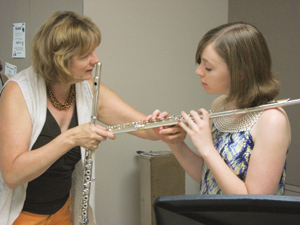 What do you look for when a student is auditioning for you?
What do you look for when a student is auditioning for you?
I look for solid fundamentals, musical sensibility and a willingness to receive input. Hopefully good hand position and body alignment are in place as well. While these can be modified, it is a struggle the longer a flutist has been playing incorrectly. The biggest problems I see are poor rhythm and inconsistent intonation, both sagging pitch in piano passages and at phrase endings and sharpness in forte passages.
What is the best repertoire to play for an audition?
Mozart Concerti or Bach Sonatas are almost always universally required. The French repertoire always allows the opportunity to show nuance, color, flexibility, and technical prowess. I believe it certainly shows an enterprising nature in a flutist when he performs compositions that include extended techniques.
What are your personal goals as a performer and teacher?
As a performer, I would like to do some more recording. Most of the recording I have done is orchestral, and I would like to devote some serious time to a chamber music or a solo recording. In each performance my goals are to bring out what I believe are the intentions and wishes of the composer and to use as many of the tools I might have in my toolbox as possible to do this. These would be to play with as much variety as may be called for in the music especially dealing with the color, articulation, pacing, and vibrato.
As a teacher I feel it is my job to teach students how to learn, how to listen, how to diagnose, and how to fix. Sooner or later each student will be out in the world on his own and will have to become his own teacher. It is extraordinarily satisfying and rewarding to me if I am on the same page as my students in terms of the priorities I hold dear. If my students don’t start there, I think they eventually come around. I also feel it is vital that they learn that the bar can always be raised. That is why the production of art can be maddening. Perfection is unattainable, though we should always strive for it.
How do you develop concentration?
I feel lucky in that I have always been able to tune into the subject at hand to the exclusion of everything else, including the house burning down around me. However, this does not help me help my students. There are so many distractions in life and frighteningly, we seem to have shorter and shorter attention spans due in great part to the advances of electronics to simplify our lives. How many of us used to memorize phone numbers? Now with speed dial or employing the favorites feature on our phones, the recall of those numbers evaporates. I am a constant nag to my children to put their gadgets away and to focus their whole attention on a single task. With students, I see a growing trend away from natural curiosity and the lack of the recognition that what we do is difficult and cannot be achieved by the push of a few buttons on the computer. Dexterity at the computer does not translate to dexterity on an instrument. I think memorization goes a long way to capturing someone’s focus. I advocate the use of all our tools, physical muscle memory, visual recall, ear training and an understanding of music theory to truly grasp a passage. Many students stop at reading the music in front of them. This is learning at a most superficial level. Sometimes it can be amusing to have a student over to the house and have them play while the phone is ringing, kids are walking through the room asking me questions, and the dog is being a pest. Learning to keep your concentration in these circumstances might be considered effective training.
What is your daily practice life like when you are on tour with the Esplanade?
On some days, 15 minutes of warm-up is a joy, a rare treat. On others, there is more of an opportunity for leisurely practice. On tour most of our contract conditions leave us a reasonable amount of time to check into a hotel, do a little warming-up, have a nap or exercise, and grab a bite to eat before a concert. If I have more teaching in a given week, I will at least try to get some solid warm-up in. If it is a week with more playing, or some recital or chamber music work, I try to clear the calendar accordingly in preparation for these events. This is why I say practice smart and practice now when you are younger. The beneficial muscle memory established as a freshman is something that the fingers can go back and tap into. You may not think you have all the time in the world now, but trust me, you do.
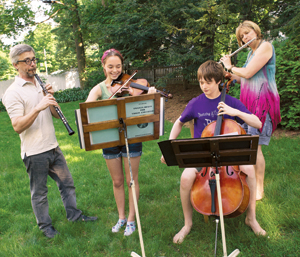 Do you and your husband play chamber music together?
Do you and your husband play chamber music together?
We play more often together in orchestra than in chamber music settings; however, we play together on occasion. Twice we have played chamber music on the Prelude series at Tanglewood. Recently we performed the Salieri Double Concerto for flute and oboe with the Boston Classical Orchestra. At home, sometimes we try to energize or break up the monotony of our kids’ practice routines by playing chamber music with them. We play the Haydn London Trios, Baroque trio sonatas, and duets.
Currently Toote is serving a three year term on the National Flute Association’s Board of Directors. Previously she was the Program Chair for the 2009 NFA Convention in New York City. This August she will perform Martin Amlin’s Concerto for Flute/Piccolo and Orchestra on the Saturday evening Gala concerto program.
• • •
Advice for Students
To be successful, you need four things in equal amounts:
1. Raw Materials: You must have good tone production, rhythm, pitch, ear, and musical sense.
2. Discipline: You must look forward to locking yourself into a tiny cubicle and listening critically for many hours a day. Listen, observe, diagnose, and improve your work. Practice what you can’t do, not what you can do. Practice for 20 minutes, record your efforts for 5, then listen back. This also affords the opportunity to rest and stretch before the next 20 minute session. I cannot stress how important it is to record yourself and learn from your observations. Today this could not be any easier so there is no excuse for not doing so. I often tell my incredulous students that “Back in my day, when the great lizards roamed the earth, a recording device was the size of a small television.”
3. Resilience: If you took a series of auditions for summer festivals and nothing panned out, pick thyself up and get thee to a masterclass. I keep meaning to purchase a stand-up punching clown for my studio at school, both for the stress relief and for the physical reminder of what it means to bounce back. We all experience rejection. It is part of the process. What doesn’t kill us makes us stronger. That sort of spiritual toughness is what is needed to carry on.
4. Creativity: These days, the people who survive the long drought after graduating from school are those who know how to see and create opportunities. They subscribe to Flute Talk, the flutelist, NFA and mine all possibilities. They enter competitions; they create websites; they make contacts; they offer their services for lessons or concerts free of charge to keep their name out there and their playing in top form; and they band together with other musicians they have met at school, classes and festivals to form a conductor-less orchestra or a flute ensemble.
Lastly, it does not hurt to develop or pursue an interest in a tangential side line. If math and physics interest you, take some acoustics courses at school and apprentice at a flute maker’s shop. If you have good people skills, see if your school has an Arts Management program. Offer free masterclasses at local schools and have business cards or a website advertising you as a teacher. All of these side lines may help you pay the rent while you prepare for that next audition.

